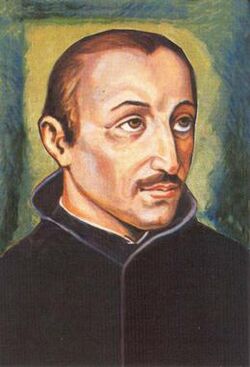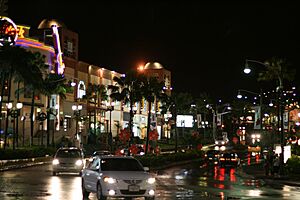Diego Luis de San Vitores facts for kids
Quick facts for kids BlessedDiego Luis de San Vitores S.J. |
|
|---|---|
 |
|
| Martyr | |
| Born | November 12, 1627 Burgos, Spanish Empire |
| Died | April 2, 1672 (aged 44) Tumon, Guam, Captaincy General of the Philippines |
| Venerated in | Roman Catholic Church |
| Beatified | October 6, 1985, Vatican by Pope John Paul II |
| Feast | October 6 |
Diego Luis de San Vitores (born November 12, 1627 – died April 2, 1672) was a Jesuit missionary from Spain. He is known for starting the first Catholic church on the island of Guam. He helped bring Christianity to the Mariana Islands. Some people have different views on his role in the conflicts that happened between the Spanish and the Chamorro people.
Contents
Early Life and Calling
Diego Luis de San Vitores was born on November 12, 1627, in Burgos, Spain. His full name was Diego Jerónimo de San Vitores y Alonso de Maluendo. He came from a noble family. His parents wanted him to become a soldier. However, Diego chose to follow his religious calling instead.
In 1640, he joined the Jesuits, a religious group. He became a priest in 1651. San Vitores asked to be sent on a mission to the Philippines, and his wish was granted.
In 1662, San Vitores visited Guam while on his way to the Philippines. He promised himself that he would return to the island. Three years later, he used his connections with the royal family. He convinced King Philip IV and Queen Mariana of Spain to start a mission in Guam.
Mission to Guam
In 1668, San Vitores sailed from Acapulco, Mexico, to Guam. He named the Chamorro islands "Islas Marianas" (Mariana Islands). This was to honor Queen Mariana of Austria and the Blessed Virgin Mary. The missionary landed in the village of Hagåtña on Guam. Chief Kepuha welcomed him. Chief Kepuha's family gave land to build Guam's first Catholic mission. On February 2, 1669, San Vitores opened the first Catholic Church in Hagåtña. He named it "Dulce Nombre de Maria," meaning "the sweet name of Mary."
At first, the Chamorro people welcomed San Vitores and the other missionaries. Many people quickly became Catholic. Some leaders may have thought this would improve their social standing. Other village chiefs wanted priests for their own villages. Some islanders even got baptized more than once to receive gifts like beads and clothing.
However, this excitement for Catholicism did not last long. The new religion caused problems with the Chamorro's traditional way of life. The church taught that all baptized people were equal in God's eyes. This went against the Chamorro's existing social system. The missionaries also tried to change long-standing Chamorro beliefs. For example, the Chamorro people honored their ancestors. They kept the skulls of deceased family members in special places in their homes. They believed this allowed their ancestors to stay close. They often asked their ancestors for guidance. The missionaries told the Chamorros that their ancestors were in hell because they had not been baptized as Christians. Destroying these honored ancestral skulls was seen as a very disrespectful act by the missionaries.
After Chief Kepuha died in 1669, relations between the Spanish missionaries and the Chamorro people got worse. The Chamorro–Spanish War began in 1671. Maga'låhi (Chief) Hurao led the Chamorro side. After several attacks on the Spanish mission, peace was negotiated.
San Vitores wanted to be like Francis Xavier, who did not use soldiers in his missions. However, he also felt that soldiers were needed to protect the priests in Guam. In 1672, San Vitores ordered churches to be built in four villages, including Merizo. Later that year, Chamorro resistance grew stronger. San Vitores and his helper, Pedro Calungsod, were killed by Matå'pang and Hurao.
Recognition by the Church
The process to make San Vitores a saint began on March 16, 1695. He was given the title Servant of God.
Oscar Calvo was important in bringing the Catholic Church back to Guam after the Japanese occupation of Guam. He worked for many years to have San Vitores recognized by the church. Calvo helped spread information about San Vitores. He visited Spain to find more details about him. Eventually, he had a book about San Vitores translated into English. In 1985, Pope John Paul II officially declared San Vitores "Blessed" in Rome.
Memorials
The San Vitores Martyrdom Site is a historical place. It is listed on the U.S. National Register of Historic Places.
Guam Highway 14 is named Pale San Vitores Road. It goes through the tourist areas around Tumon Bay. There is also a church named Blessed Diego Luis de San Vitores Church. It is located at 884 Pale San Vitores Road.
See also
 In Spanish: Diego Luis de San Vitores para niños
In Spanish: Diego Luis de San Vitores para niños
Images for kids



